Antibody data
- Antibody Data
- Antigen structure
- References [1]
- Comments [0]
- Validations
- Immunocytochemistry [3]
- Immunohistochemistry [8]
- Other assay [1]
Submit
Validation data
Reference
Comment
Report error
- Product number
- PA5-54628 - Provider product page

- Provider
- Invitrogen Antibodies
- Product name
- PFAS Polyclonal Antibody
- Antibody type
- Polyclonal
- Antigen
- Recombinant protein fragment
- Description
- Immunogen sequence: ALERVLRLPA VASKRYLTNK VDRSVGGLVA QQQCVGPLQT PLADVAVVAL SHEELIGAAT ALGEQPVKSL LDPKVAARLA VAEALTNLVF ALVTDLRDVK CSG Highest antigen sequence identity to the following orthologs: Mouse - 95%, Rat - 96%.
- Reactivity
- Human
- Host
- Rabbit
- Isotype
- IgG
- Vial size
- 100 μL
- Concentration
- 0.05 mg/mL
- Storage
- Store at 4°C short term. For long term storage, store at -20°C, avoiding freeze/thaw cycles.
Submitted references Systems analysis of intracellular pH vulnerabilities for cancer therapy.
Persi E, Duran-Frigola M, Damaghi M, Roush WR, Aloy P, Cleveland JL, Gillies RJ, Ruppin E
Nature communications 2018 Jul 31;9(1):2997
Nature communications 2018 Jul 31;9(1):2997
No comments: Submit comment
Supportive validation
- Submitted by
- Invitrogen Antibodies (provider)
- Main image
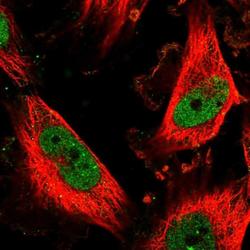
- Experimental details
- Immunofluorescent staining of PFAS in human cell line U-251 MG shows positivity in nucleus but excluded from the nucleoli. Samples were probed using a PFAS Polyclonal Antibody (Product # PA5-54628).
- Submitted by
- Invitrogen Antibodies (provider)
- Main image
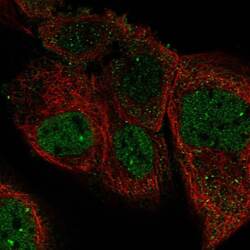
- Experimental details
- Immunofluorescent staining of PFAS in human cell line A-431 using a PFAS Polyclonal Antibody (Product # PA5-54628) shows localization to nucleoplasm.
- Submitted by
- Invitrogen Antibodies (provider)
- Main image
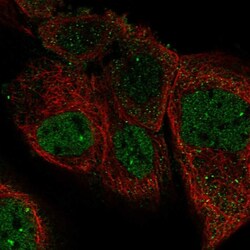
- Experimental details
- Immunofluorescent staining of PFAS in human cell line A-431 using a PFAS Polyclonal Antibody (Product # PA5-54628) shows localization to nucleoplasm.
Supportive validation
- Submitted by
- Invitrogen Antibodies (provider)
- Main image
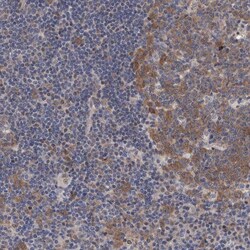
- Experimental details
- Immunohistochemical staining of PFAS in human tonsil using a PFAS Polyclonal Antibody (Product # PA5-54628) shows cytoplasmic positivity in germinal center cells and non-germinal center cells.
- Submitted by
- Invitrogen Antibodies (provider)
- Main image
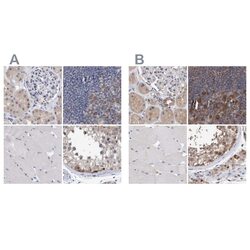
- Experimental details
- Immunohistochemical staining of PFAS in human kidney, lymph node, skeletal muscle and testis using PFAS Polyclonal Antibody (Product # PA5-54628) (A) shows similar protein distribution across tissues to an independent PFAS Polyclonal Antibody (B).
- Submitted by
- Invitrogen Antibodies (provider)
- Main image
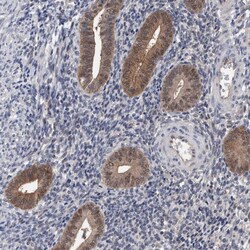
- Experimental details
- Immunohistochemical staining of PFAS in human endometrium using PFAS Polyclonal Antibody (Product # PA5-54628) shows weak to moderate cytoplasmic positivity in glandular cells.
- Submitted by
- Invitrogen Antibodies (provider)
- Main image

- Experimental details
- Immunohistochemical staining of PFAS in human tonsil using PFAS Polyclonal Antibody (Product # PA5-54628) shows moderate cytoplasmic positivity in germinal center cells.
- Submitted by
- Invitrogen Antibodies (provider)
- Main image
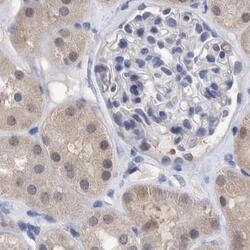
- Experimental details
- Immunohistochemical staining of PFAS in human kidney using PFAS Polyclonal Antibody (Product # PA5-54628).
- Submitted by
- Invitrogen Antibodies (provider)
- Main image
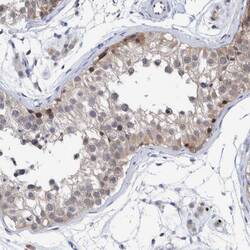
- Experimental details
- Immunohistochemical staining of PFAS in human testis using PFAS Polyclonal Antibody (Product # PA5-54628) shows weak to moderate nuclear positivity in a subset of cells in seminiferous ducts.
- Submitted by
- Invitrogen Antibodies (provider)
- Main image
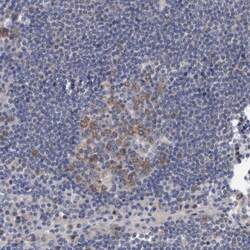
- Experimental details
- Immunohistochemical staining of PFAS in human lymph node using PFAS Polyclonal Antibody (Product # PA5-54628) shows weak to moderate cytoplasmic positivity in germinal center cells.
- Submitted by
- Invitrogen Antibodies (provider)
- Main image
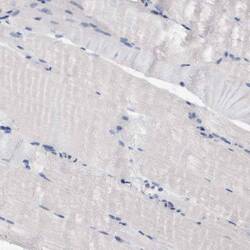
- Experimental details
- Immunohistochemical staining of PFAS in human skeletal muscle using PFAS Polyclonal Antibody (Product # PA5-54628) shows no positivity as expected.
Supportive validation
- Submitted by
- Invitrogen Antibodies (provider)
- Main image

- Experimental details
- Fig. 4 Validation of systems analyses in predicting pHi-sensitive metabolic vulnerabilities. a pHi measurements of naive and acid-adapted (AA) breast cancer MCF7 cells, under normoxia and following the inhibition of NHE1 , by cariporide treatment. For pHi measurments at least 30 cells were analyzed. b Efficiency of knockdown of indicated targets at the mRNA and protein levels, following reverse transfection of MCF7 cells with the indicated siRNAs. qPCR was repeated at least three times with three replicates. c The effect of gene inhibition in normal and low extracellular pH (pHe) shown for naive and AA MCF7 breast cancer cells. Similar color code to Fig. 3 is applied. At low pHe where the lowest pHi was obtained there is a large reduction in the viability of cells. In AA cells, only the selective and pH-specific targets ( GAPDH , GPI , and ACAT2 ) achieve amplified anti-proliferative effects following NHE1 inhibition, despite the smaller reduction in the pHi of these cells. PFAS , a selective but not pH-specific target, is similar to control cells following NHE1 inhibition. Knockdown of RPIA had a weak effect in naive cells and no/opposite effects in AA cells. The viability assay was done three times with four replicates each time. The bars depict the mean and the error bars depict the standard deviation of the mean
 Explore
Explore Validate
Validate Learn
Learn Western blot
Western blot Immunocytochemistry
Immunocytochemistry